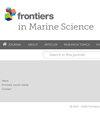Environmental and behavioral drivers of Automatic Identification System gaps of Turkish trawlers in the Black Sea
IF 3
2区 生物学
Q1 MARINE & FRESHWATER BIOLOGY
引用次数: 0
Abstract
This study investigates the spatial, temporal, environmental, and behavioral drivers of Automatic Identification System (AIS) signal gaps in trawl fishing vessels operating in the Black Sea. AIS deliberate or accidental signal gaps, which may cause vessels to become temporarily invisible to AIS-based surveillance systems, hinder maritime monitoring, compliance enforcement, and fisheries management — even though such vessels may still be detectable via alternative systems such as VMS. The analysis focused on two primary trawl types; bottom and pelagic trawl. Using a comprehensive dataset of AIS signals, environmental variables and vessel activity, the study integrated spatial and temporal analyses with XGBoost machine learning technique to identify key predictors of AIS gaps. The results reveal distinct seasonal and spatial patterns in AIS gap behavior, with significant variation between trawl types. For bottom trawls, AIS gaps were concentrated near the northern entrance of the Istanbul Strait, while pelagic trawls exhibited broader distributions along the Black Sea coast, particularly near Zonguldak and Samsun. Machine learning model demonstrated strong predictive performance, with an accuracy of 80.26%, AUC of 0.8855, TSS of 0.6052, MAE of 1336.74 minutes, and RMSE of 3205.54 minutes for bottom trawls. For pelagic trawls, the model achieved 61.68% accuracy, an AUC of 0.6663, TSS of 0.2336, MAE of 2011.05 minutes, and RMSE of 4400.40 minutes, indicating moderate predictive capabilities. Key predictors included environmental factors such as chlorophyll concentration and sea surface temperature, alongside spatial metrics like depth and proximity to shore and port. Partial dependence plots highlighted the non-linear effects of these variables, with chlorophyll concentration showing a critical threshold around 3.5 mg/m³ and sea surface temperature influencing gaps most significantly at approximately 15°C. This study provides the first systematic analysis of AIS gaps in Black Sea fisheries, contributing valuable insights into their drivers and implications for fisheries management. By identifying high-risk zones and temporal patterns, the findings could support improved monitoring strategies, regulatory enforcement, and sustainable resource use in this ecologically significant region.黑海土耳其拖网渔船自动识别系统漏洞的环境和行为驱动因素
本研究探讨了黑海拖网渔船自动识别系统(AIS)信号间隙的空间、时间、环境和行为驱动因素。AIS故意或意外的信号间隙可能会导致船舶暂时无法被基于AIS的监视系统发现,从而阻碍海事监测、合规执行和渔业管理——尽管这些船舶仍然可以通过VMS等替代系统检测到。分析集中在两种主要的拖网类型;海底和远洋拖网。该研究利用AIS信号、环境变量和船舶活动的综合数据集,将空间和时间分析与XGBoost机器学习技术相结合,以确定AIS差距的关键预测因素。结果表明,不同拖网类型之间存在明显的季节和空间差异。对于底拖网渔船,AIS缺口集中在伊斯坦布尔海峡北部入口附近,而远洋拖网渔船沿着黑海海岸的分布范围更广,特别是在宗乌尔达克和萨姆孙附近。机器学习模型对海底拖网的预测准确率为80.26%,AUC为0.8855,TSS为0.6052,MAE为1336.74分钟,RMSE为3205.54分钟。对于远洋拖网,模型准确率为61.68%,AUC为0.6663,TSS为0.2336,MAE为2011.05 min, RMSE为4400.40 min,预测能力一般。关键的预测因素包括叶绿素浓度和海面温度等环境因素,以及深度和距离海岸和港口的距离等空间指标。部分相关图突出了这些变量的非线性影响,叶绿素浓度在3.5 mg/m³左右显示出一个临界阈值,海面温度在大约15°C时对间隙的影响最为显著。本研究首次对黑海渔业的AIS差距进行了系统分析,为其驱动因素和对渔业管理的影响提供了有价值的见解。通过确定高风险区域和时间模式,研究结果可以为改进监测策略、监管执法和可持续资源利用提供支持。
本文章由计算机程序翻译,如有差异,请以英文原文为准。
求助全文
约1分钟内获得全文
求助全文
来源期刊

Frontiers in Marine Science
Agricultural and Biological Sciences-Aquatic Science
CiteScore
5.10
自引率
16.20%
发文量
2443
审稿时长
14 weeks
期刊介绍:
Frontiers in Marine Science publishes rigorously peer-reviewed research that advances our understanding of all aspects of the environment, biology, ecosystem functioning and human interactions with the oceans. Field Chief Editor Carlos M. Duarte at King Abdullah University of Science and Technology Thuwal is supported by an outstanding Editorial Board of international researchers. This multidisciplinary open-access journal is at the forefront of disseminating and communicating scientific knowledge and impactful discoveries to researchers, academics, policy makers and the public worldwide.
With the human population predicted to reach 9 billion people by 2050, it is clear that traditional land resources will not suffice to meet the demand for food or energy, required to support high-quality livelihoods. As a result, the oceans are emerging as a source of untapped assets, with new innovative industries, such as aquaculture, marine biotechnology, marine energy and deep-sea mining growing rapidly under a new era characterized by rapid growth of a blue, ocean-based economy. The sustainability of the blue economy is closely dependent on our knowledge about how to mitigate the impacts of the multiple pressures on the ocean ecosystem associated with the increased scale and diversification of industry operations in the ocean and global human pressures on the environment. Therefore, Frontiers in Marine Science particularly welcomes the communication of research outcomes addressing ocean-based solutions for the emerging challenges, including improved forecasting and observational capacities, understanding biodiversity and ecosystem problems, locally and globally, effective management strategies to maintain ocean health, and an improved capacity to sustainably derive resources from the oceans.
 求助内容:
求助内容: 应助结果提醒方式:
应助结果提醒方式:


